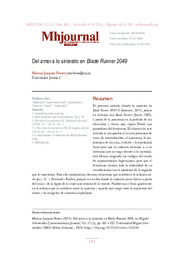Por favor, use este identificador para citar o enlazar este ítem:
https://hdl.handle.net/11000/26370Registro completo de metadatos
| Campo DC | Valor | Lengua/Idioma |
|---|---|---|
| dc.contributor.author | Ferrer, Marcos Joaquín | - |
| dc.date.accessioned | 2022-03-28T09:09:36Z | - |
| dc.date.available | 2022-03-28T09:09:36Z | - |
| dc.date.created | 2021-01-31 | - |
| dc.identifier.citation | Vol. 12 (2021) | es_ES |
| dc.identifier.issn | 1989-8681 | - |
| dc.identifier.uri | http://hdl.handle.net/11000/26370 | - |
| dc.description.abstract | MHCJ Vol. 12 (1) | Año 2021 - Artículo nº 9 (176) - Páginas 181 a 202 - mhjournal.org181ResumenEl presente artículo aborda lo siniestro en Blade Runner 2049 (Villeneuve, 2017), puesta en relación con Blade Runner (Scott, 1982), a partir de la presencia en la película de los elementos y temas que, según Freud, son portadores del fenómeno. El objetivo de este artículo es comprobar si la mera presencia de estos (la incertidumbre, el animismo, la am-putación de los ojos, el doble y la repetición) basta para que lo siniestro irrumpa, o si es necesario que su carga alcance a la materiali-dad fílmica, rasgando los códigos del modo de representación hegemónica, para que el fenómeno alcance toda la radicalidad de su manifestación con la aparición de la angustia que le caracteriza. Para ello analizaremos diversas secuencias que establecen la relación en-tre Joi y `K ́ y Deckard y Rachel, porque es en ellas donde lo siniestro toma forma a partir del amor y de la figura de la mujer que retorna de la muerte. Pondremos el foco igualmente en la relación que se establece entre lo siniestro y aquello que surge entre la resistencia del sujeto y las imágenes de consumo capitalistas. | es_ES |
| dc.description.abstract | This article addresses the sinister in Blade Runner 2049 (Villeneuve, 2017), related to Blade Runner (Scott, 1982), starting with the elements and themes that, according to Freud, were the carriers of the phe-nomenon. The objective of this article is to check if the mere presence of these (the uncertainty, the animism, the eyes amputation, the doppelganger, and the repetition) in the film is enough for the sinister to erupt. Another way of checking the sinister’s presence is by looking at the filmic materiality tearing the codes of the hegemonic mode of representation. This way the phenomenon would reach all the radicality of its manifestation with the apparition of the anguish. In order to do this, we will base ourselves on various sequences that estab-lish the relationship between Joi and `K ́ and the one between Deckard and Rachel. It is in these relationships where the sinister takes shape from love and death in the figure of the woman who returns from death. We will also focus on the connection that is established between the sinister and the result of combining the resistance of the subject with the images of capitalist consumption. | es_ES |
| dc.format | application/pdf | es_ES |
| dc.format.extent | 22 | es_ES |
| dc.language.iso | spa | es_ES |
| dc.publisher | Universidad Miguel Hernández de Elche | es_ES |
| dc.rights | info:eu-repo/semantics/openAccess | es_ES |
| dc.rights | Attribution-NonCommercial-NoDerivatives 4.0 Internacional | * |
| dc.rights.uri | http://creativecommons.org/licenses/by-nc-nd/4.0/ | * |
| dc.subject | Siniestro | es_ES |
| dc.subject | representación | es_ES |
| dc.subject | capitalismo | es_ES |
| dc.subject | muerte | es_ES |
| dc.subject | amor | es_ES |
| dc.subject | replicante | es_ES |
| dc.subject.other | CDU::3 - Ciencias sociales | es_ES |
| dc.title | Del amor a lo siniestro en Blade Runner 2049 | es_ES |
| dc.title.alternative | From love to the sinister in Blade Runner 2049 | es_ES |
| dc.type | info:eu-repo/semantics/article | es_ES |
| dc.identifier.doi | 10.21134/mhcj.v12i.944 | - |
| dc.relation.publisherversion | https://doi.org/10.21134/mhcj.v12i.944 | - |

Ver/Abrir:
944-Texto del artículo-5273-2-10-20210131.pdf
1,68 MB
Adobe PDF
Compartir:
 La licencia se describe como: Atribución-NonComercial-NoDerivada 4.0 Internacional.
La licencia se describe como: Atribución-NonComercial-NoDerivada 4.0 Internacional.
.png)